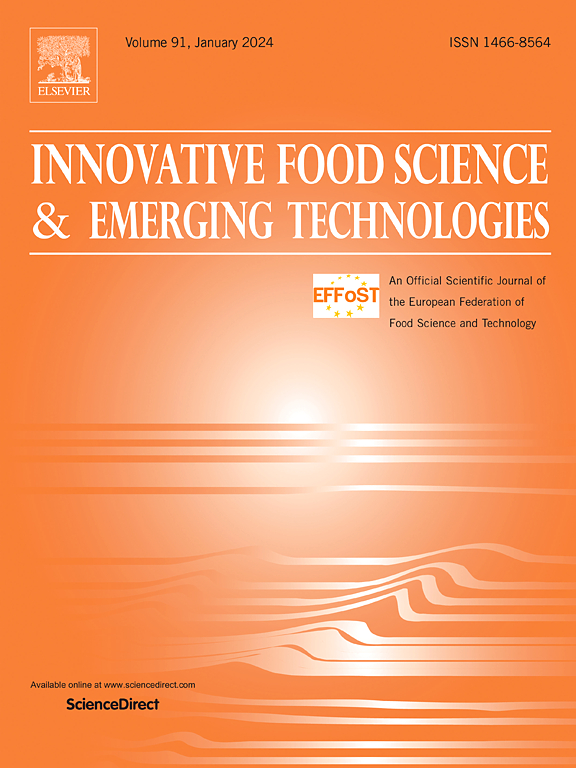Performance assessment of an advanced solar concatenated sugarcane juice distiller
IF 6.8
1区 农林科学
Q1 FOOD SCIENCE & TECHNOLOGY
Innovative Food Science & Emerging Technologies
Pub Date : 2025-06-27
DOI:10.1016/j.ifset.2025.104102
引用次数: 0
Abstract
Non-centrifugal sugar products like khandsari and jaggery retains more nutrients unlike centrifugated sugar products like refined sugar and white sugar. Growing demands of healthier food has boosted the demand for non-centrifugal sugar. However, the small scale non-centrifugal sugar industries remain highly unorganized and relies on environmentally harmful conventional energy resources like bagasse, wood and fossil fuels for obtaining concentrated sugarcane juice. So, in the present study a solar driven advanced concatenated sugarcane juice distiller (ACSJD) was tested for obtaining high total soluble solids (TSS) value in concentrated sugarcane juice as primary output and distilled water as its byproduct. The ACSJD was equipped with reflectors (internal & external), fins, wick material and glass cooling mechanism. The assessment of the ACSJD is carried out on the basis of thermal performance, environmental impact and economic viability which was also parallelly compared with a simple concatenated sugarcane juice distiller (SCSJD). The ACSJD was supplied with raw sugarcane juice (14.2°Brix) at 50 ml/min flow rate. The system was observed to produce concentrated sugarcane juice of 38.2°Brix which is higher than any other solar distiller reported yet. The distillate output of ACSJD is 5.65 kg/day which is 45.0 % higher than the SCSJD. The total internal heat transfer coefficient of ACSJD was 71.25 W/m2°C which was observed to be 73.95 % higher than that of SCSJD. The yearlong energy output of ACSJD was 1188.6 kWh with 44.18 days shorter energy payback time than SCSJD. The ACSJD generated $ 43,165.26 carbon credits, with 62.14 days shorter economic recovery time than SCSJD.
一种新型太阳能串联甘蔗汁蒸馏器的性能评价
与精制糖和白糖等离心糖产品不同,非离心糖产品(如khandsari和jaggery)保留了更多的营养。对健康食品日益增长的需求推动了对非离心糖的需求。然而,小规模的非离心制糖业仍然高度无组织,依赖于对环境有害的传统能源,如甘蔗渣、木材和化石燃料来获得浓缩的甘蔗汁。因此,本研究对太阳能驱动的先进浓缩甘蔗汁蒸馏器(ACSJD)进行了测试,以获得高总可溶性固溶物(TSS)值的浓缩甘蔗汁为主要产品,蒸馏水为副产物。ACSJD配备了反射器(内部&;外部),翅片,灯芯材料和玻璃冷却机构。对ACSJD的热性能、环境影响和经济可行性进行了评估,并与简单的串联甘蔗汁蒸馏器(SCSJD)进行了平行比较。ACSJD以50 ml/min流速提供生甘蔗汁(14.2°白利度)。据观察,该系统生产的浓缩甘蔗汁的糖度为38.2°,高于目前报道的任何其他太阳能蒸馏器。ACSJD的馏出物产量为5.65 kg/d,比SCSJD高出45.0%。ACSJD的总内换热系数为71.25 W/m2°C,比SCSJD高73.95%。ACSJD的年发电量为1188.6 kWh,能源回收期比SCSJD短44.18 d。ACSJD产生了43,165.26美元的碳信用额,经济恢复时间比SCSJD短62.14天。
本文章由计算机程序翻译,如有差异,请以英文原文为准。
求助全文
约1分钟内获得全文
求助全文
来源期刊
CiteScore
12.00
自引率
6.10%
发文量
259
审稿时长
25 days
期刊介绍:
Innovative Food Science and Emerging Technologies (IFSET) aims to provide the highest quality original contributions and few, mainly upon invitation, reviews on and highly innovative developments in food science and emerging food process technologies. The significance of the results either for the science community or for industrial R&D groups must be specified. Papers submitted must be of highest scientific quality and only those advancing current scientific knowledge and understanding or with technical relevance will be considered.

 求助内容:
求助内容: 应助结果提醒方式:
应助结果提醒方式:


